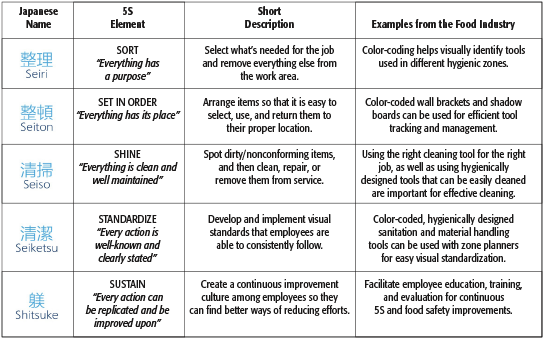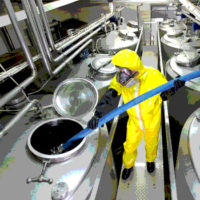5S has been shown to be an effective Japanese-based model for increasing operational efficiency along with improving food safety and quality in food processing plants. The main goal of 5S is to help companies create safe, neat, clean, and structured workplaces with reduced waste. Because over 85 percent of food safety issues in a site are generally caused by failures in Good Manufacturing Practices (GMPs) rather than Hazard Analysis and Critical Control Points plan shortcomings, 5S has gained prominence industry-wide as a way to comply with Food Safety Modernization Act-based regulations that focus on prevention.
5S Principles

Key Benefits of 5S to a Food Processor
1. Supports company-wide integration of work processes through the participation of all employees;
2. Creates a stable foundation for the systematic implementation of lean manufacturing practices that are required to reduce wastes and inconsistencies, and thus promotes value-added work;
3. Raises employee morale and motivation through hands-on participation;
4. Streamlines processes and reduces operating costs; and
5. Engages employees with helping to create a safer and more sustainable workplace.
How to Implement 5S in the Food Industry
Senior employees and management are likely all aware of 5S as a concept, but implementation requires a closer collaboration with the workers.
Set the Scope: Since 5S can apply to any organizational sector, goods/services mix, to different areas, equipment, items, people, etc., it’s important to set a project scope for its introduction. After addressing food safety and quality issues in a plant, 5S can be used to specifically focus on lowering operation costs or environmental impacts. The most practical way to focus 5S efforts within a food facility is to align their key compliance expectations to GMPs, and food safety and sanitation practices.
Management Commitment and Employee Motivation: The 5S method applies to work processes, which the front-line employees are in charge of—therefore, 5S belongs to them and they need to be educated, trained, refreshed, and motivated on it. This won’t be possible if management isn’t committed to providing leadership, resources, and support to the 5S endeavor, though.
Educate and Train Employees: For 5S to be effective, allocate each responsible employee a work zone. Educate, train, and refresh them regularly (or as required) on their zone’s tasks. 5S is a visual method, so let employees explore which methods they think will best work, as their ideas are likely to be the most successful. As Senge (2006) puts it, when understanding work systems, keep it simple since the dynamic complexity matters more than just the mere details.
Review Improvements: To sustain 5S improvements, create a review system in which employees are trained to audit other departments. They don’t need a long checklist, instead, simply divide the review work into chunks and allocate to different groups on a rotational basis. Let employees meet frequently for 10–15 minutes to discuss and suggest solutions to food safety and quality issues.
5S can promote improvement in sanitation, hygiene and material handling standards within a food facility. Better operational efficiencies can also be realized by using high quality, color-coded, hygienically designed tools and equipment that have a standardized criterion of selection, storage, care, and maintenance requirements. This eventually helps with maintaining sanitary conditions within a site, which is necessary to ensure compliance to food safety and sanitation regulatory, industry standards and customer expectations. Thus, the 5S method, when consistently practiced, can make a great difference in preventing or reducing food safety violations, food recalls and foodborne illnesses.
If you’d like to learn more about this, you can read Remco Products article, “5S in the Food Industry,” at this link.
Resources
Borges Lopes, R, F Freitas, and I Sousa. 2015. “Application of Lean Manufacturing Tools in the Food and Beverage Industries. J Technol Manag Innov 10(3):120–130.
www.vikan.com/us/knowledge-center/download-center/.
Evans, JR and WM Lindsay. Managing for quality and performance excellence (Cengage Learning, 2013).
Senge, PM. The Fifth Discipline: The Art and Practice of the Learning Organization (Broadway Business, 2006).
Yiannas, F. Food Safety Culture: Creating a Behavior-Based Food Safety Management System (Springer Science & Business Media, 2008).




